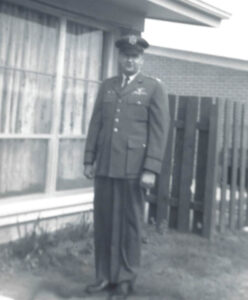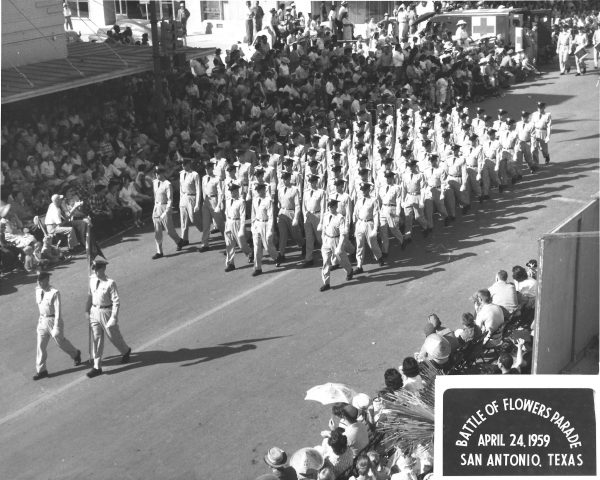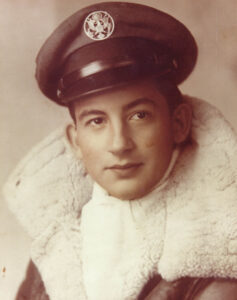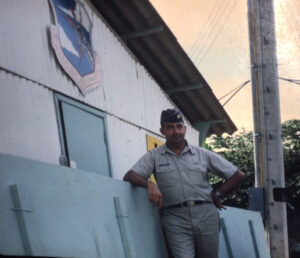“I dreamed of flying airplanes; I dreamed of becoming a courageous soldier; I dreamed of finding a beautiful girl to accompany me through life; I dreamed of love, happiness, children, grandchildren, education, wealth, and a long life.” Donald Rose, USAF Major, Retired.
Major Donald Rose (Ret.), an enrolled member of the Eastern Band of Cherokee Indians, is a veteran of the Korean War, Vietnam, the Cold War, and the Cuban Missile Crisis. He was born on the Cherokee Reservation in 1932 as the oldest of 12 brothers and sisters. He attended the reservation boarding school through the 10th grade. In June of 1949, at the age of 17, he enlisted in the United States Air Force and began a 25-year career that helped fulfill his childhood dreams. After basic training at Lackland AFB, Texas and communications specialist schooling at Keesler AFB, MS., his first duty assignment was to the 1935th AACS Squadron at Bluie West One, Greenland in 1950.

Major Donald Rose (Ret.), then a Captain, is shown serving in the B-52 force with the 97th Bomb Wing at Blytheville, AFB, Arkansas.
“My tour in Greenland was a unique experience,” Maj. Rose wrote in his book “Lucky Duck”. “I was 18 when I arrived at the remote base that housed a short runway and refueling station within walking distance of the edge of the Greenland Ice Cap. For six months of the year, 25 of us were assigned to an ad hoc Range Station on a tiny coastal Island. We operated a direction finding system, air traffic control, reported weather observations and forecast. Our jobs were critical to the safe flight of aircraft across the North Atlantic. We helped save quite a few aircraft during my time there.”
1952 was a busy year for him, and on Oct. 11 of that year he married Carolyn Voyles and they began a family. They had five children during their moves from base to base. “Carolyn and the kids became experts at packing and moving.”
At Biggs Field, Texas he flew as a radio operator on B-29s with the 97th bomber wing. He completed transition training into the KC-97 aerial refueling aircraft at Kelly, AFB, Texas and was assigned to the 26th Air Refueling Squadron at Lockbourne AFB, OH.
“I should have been discharged in June 1952, but because of the Korean War, my tour of duty was involuntarily extended. I was promoted to Sergeant and began flying long missions to refuel B-50 Bombers, F-80 and F-84 fighters, and the B-45 bombers. The bombers were loaded with high octane aviation fuel and the aircraft had a history of crashing. We lost a lot of them and they took a lot of good men with them.”
He then served a tour in French Morocco at Ben Guerir Air Base supporting Strategic Air Command unit rotations, then to Base Flight at Pinecastle AFB in Florida, followed by Radar Maintenance School at Keesler AFB in Mississippi where he became an instructor.
Maj. Rose was a Staff Sergeant with nine years in grade when he decided to apply to Officers Candidate School. He continued his education at night school earning enough college credit to be accepted to Officers Candidate School (OCS) in 1959. He graduated OCS with a commission of 2nd Lieutenant. He earned his Navigator Wings and from there attended Electronic Warfare Officer school in Mississippi. After completing survival training and B-52 transition training, he was assigned as an Electronics Warfare Officer in the B-52 force with the 97th Bomb Wing at Blytheville, AFB, Arkansas, in October 1961.
One year later, October 1962, was the most intense period of the Cold War with the Soviets and the Cuban Missile Crisis. On Oct. 22, 1962 Strategic Air Command (SAC) went to DEFCON III. All military bases and personnel were ordered to high alert and combat ready. The 97th Bomber Wing at Blytheville placed two B-52s on airborne alert . The two B-52s carried Nuclear, AGM-28 Hound Dog and ADM-20 Quail missiles. Then as tensions grew SAC went DEFCON II. The President informed the Russians that if they did not agree to remove missiles from Cuba and turn their forces back from their approach on the United States that a military response might be taken. Both bombers were in the air as part of the alert force and were in the air awaiting orders.
“I was the Electronics Warfare Officer. As our mission began, our flight crew knew that our base was a primary Soviet target and that our families would not survive a nuclear exchange. Our aircraft carried 4 Quail missiles in the bomb bay and a Hound dog missle on each wing. We were combat ready and awaiting orders as we flew a scheduled rotation path from our base to Eastern Canada then West to the coastline of Western Canada and Alaska, refueling along the way. We were in the air 25 hours. President Kennedy issued the Stand Down order three hours before we were to begin our mission if the Russians did not comply. That’s how close we were to Nuclear war.”

Maj. Rose, then a 2nd Lt., is shown with his Officer Candidate School class marching in a parade on April 24, 1959 in San Antonio, Texas.
The crew received an Outstanding Unit Award.
By 1967, Maj. Rose was assigned to the Intelligence Division at SAC Headquarters in Omaha, Neb. His principal duty was analysis of threat to SAC aircraft operating in Southeast Asia. In April 1970, he began his overseas tour in Vietnam with the 7th Air Force. He then returned to SAC HQ in 1971 and served as Chief of the Intelligence Requirements Section until his retirement as a Major in 1974.
“The day I left to go to war is burned into my memory. As I taxied out of Eppley Field, I could see the kids staring at me. It’s an emotional and stressful experience for a family. Most of what I did there I prefer to leave there. It was a year of mixed emotions. You are never as alive as when you know that each day may be your last. Witnessing the death of friends and fellow comrades extracts a heavy toll. Knowing you are killing others from the deck of a B-52 Bomber, even when you cannot see them, is taxing on one’s conscience. ”
He added, “The scariest times were the up-country visits to fire support bases. There you were living in bunkers and ditches, surrounded by concertina wire, mines, flares and the enemy. Attacks came with marked suddenness, mostly at night. I felt lucky to make it home.”
He flew numerous combat missions during the Vietnam conflict and was awarded the Bronze Star, Meritorious Service Medal, Air Force Commendation Medal, Air Medal, and numerous service medals.
– Special to the One Feather







